Environmental Management Systems in Australian Agriculture Sector
VerifiedAdded on 2023/06/06
|9
|2292
|380
Essay
AI Summary
This essay explores the implementation of Environmental Management Systems (EMS) within the Australian agriculture sector. It defines EMS as approaches adopted to improve environmental conditions, highlighting their role in planning, implementation, review, and business operation improvement. The essay discusses the objectives of EMS, including analyzing environmental impacts, managing hazardous waste, and reducing pollution. It examines the implications of ISO 14001:2016 and ISO 14040:2006 standards, focusing on their guidelines for environmental performance and lifecycle assessments. The challenges in implementing and adopting EMS in Australian farming are addressed, including lack of awareness and policy strictness. Barriers such as certification costs and suitability for small organizations are also discussed, along with potential solutions like government-led education campaigns and addressing false assumptions. The essay concludes that the success of EMS relies on proper adoption and implementation, emphasizing the government's role in promoting and supporting these systems within the agricultural sector.
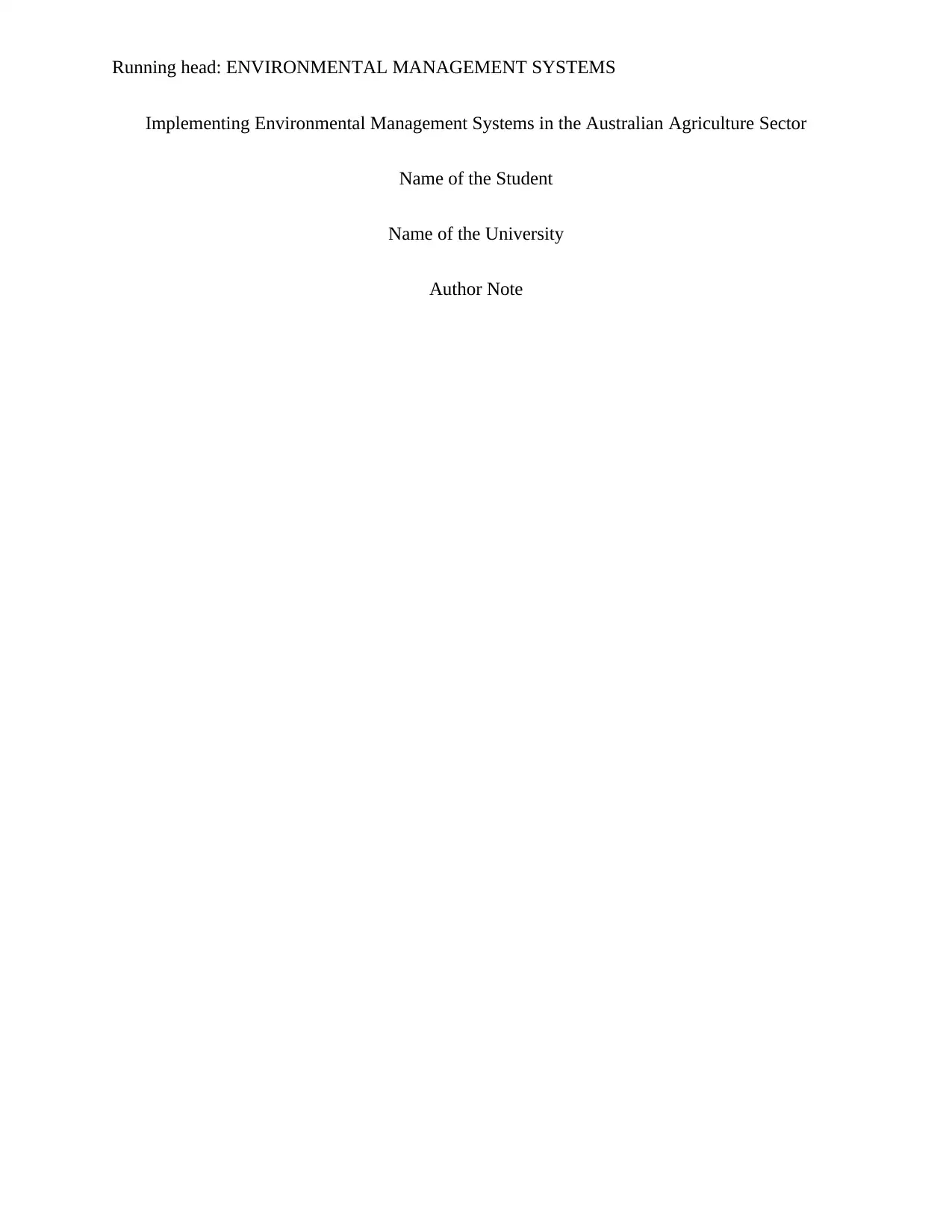
Running head: ENVIRONMENTAL MANAGEMENT SYSTEMS
Implementing Environmental Management Systems in the Australian Agriculture Sector
Name of the Student
Name of the University
Author Note
Implementing Environmental Management Systems in the Australian Agriculture Sector
Name of the Student
Name of the University
Author Note
Paraphrase This Document
Need a fresh take? Get an instant paraphrase of this document with our AI Paraphraser
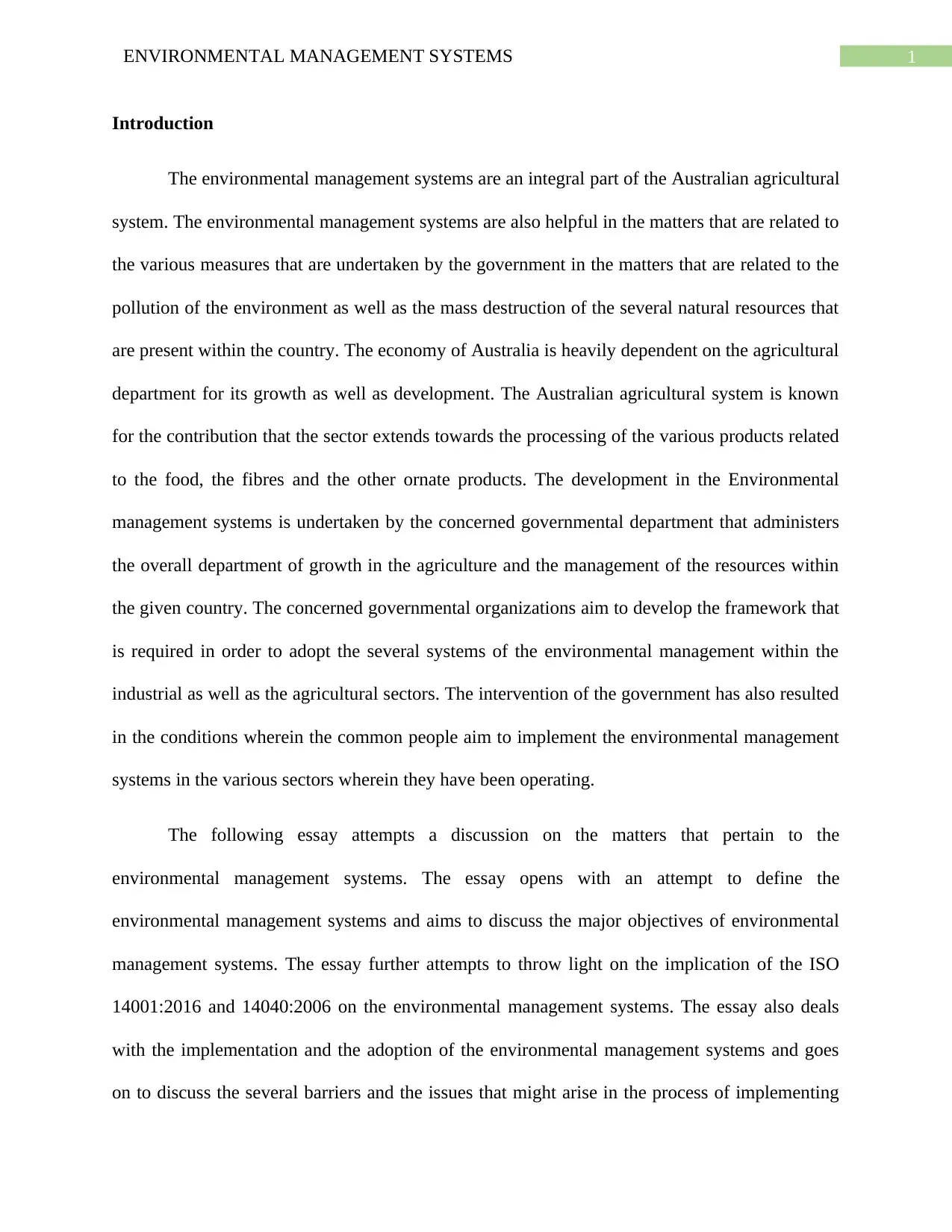
1ENVIRONMENTAL MANAGEMENT SYSTEMS
Introduction
The environmental management systems are an integral part of the Australian agricultural
system. The environmental management systems are also helpful in the matters that are related to
the various measures that are undertaken by the government in the matters that are related to the
pollution of the environment as well as the mass destruction of the several natural resources that
are present within the country. The economy of Australia is heavily dependent on the agricultural
department for its growth as well as development. The Australian agricultural system is known
for the contribution that the sector extends towards the processing of the various products related
to the food, the fibres and the other ornate products. The development in the Environmental
management systems is undertaken by the concerned governmental department that administers
the overall department of growth in the agriculture and the management of the resources within
the given country. The concerned governmental organizations aim to develop the framework that
is required in order to adopt the several systems of the environmental management within the
industrial as well as the agricultural sectors. The intervention of the government has also resulted
in the conditions wherein the common people aim to implement the environmental management
systems in the various sectors wherein they have been operating.
The following essay attempts a discussion on the matters that pertain to the
environmental management systems. The essay opens with an attempt to define the
environmental management systems and aims to discuss the major objectives of environmental
management systems. The essay further attempts to throw light on the implication of the ISO
14001:2016 and 14040:2006 on the environmental management systems. The essay also deals
with the implementation and the adoption of the environmental management systems and goes
on to discuss the several barriers and the issues that might arise in the process of implementing
Introduction
The environmental management systems are an integral part of the Australian agricultural
system. The environmental management systems are also helpful in the matters that are related to
the various measures that are undertaken by the government in the matters that are related to the
pollution of the environment as well as the mass destruction of the several natural resources that
are present within the country. The economy of Australia is heavily dependent on the agricultural
department for its growth as well as development. The Australian agricultural system is known
for the contribution that the sector extends towards the processing of the various products related
to the food, the fibres and the other ornate products. The development in the Environmental
management systems is undertaken by the concerned governmental department that administers
the overall department of growth in the agriculture and the management of the resources within
the given country. The concerned governmental organizations aim to develop the framework that
is required in order to adopt the several systems of the environmental management within the
industrial as well as the agricultural sectors. The intervention of the government has also resulted
in the conditions wherein the common people aim to implement the environmental management
systems in the various sectors wherein they have been operating.
The following essay attempts a discussion on the matters that pertain to the
environmental management systems. The essay opens with an attempt to define the
environmental management systems and aims to discuss the major objectives of environmental
management systems. The essay further attempts to throw light on the implication of the ISO
14001:2016 and 14040:2006 on the environmental management systems. The essay also deals
with the implementation and the adoption of the environmental management systems and goes
on to discuss the several barriers and the issues that might arise in the process of implementing
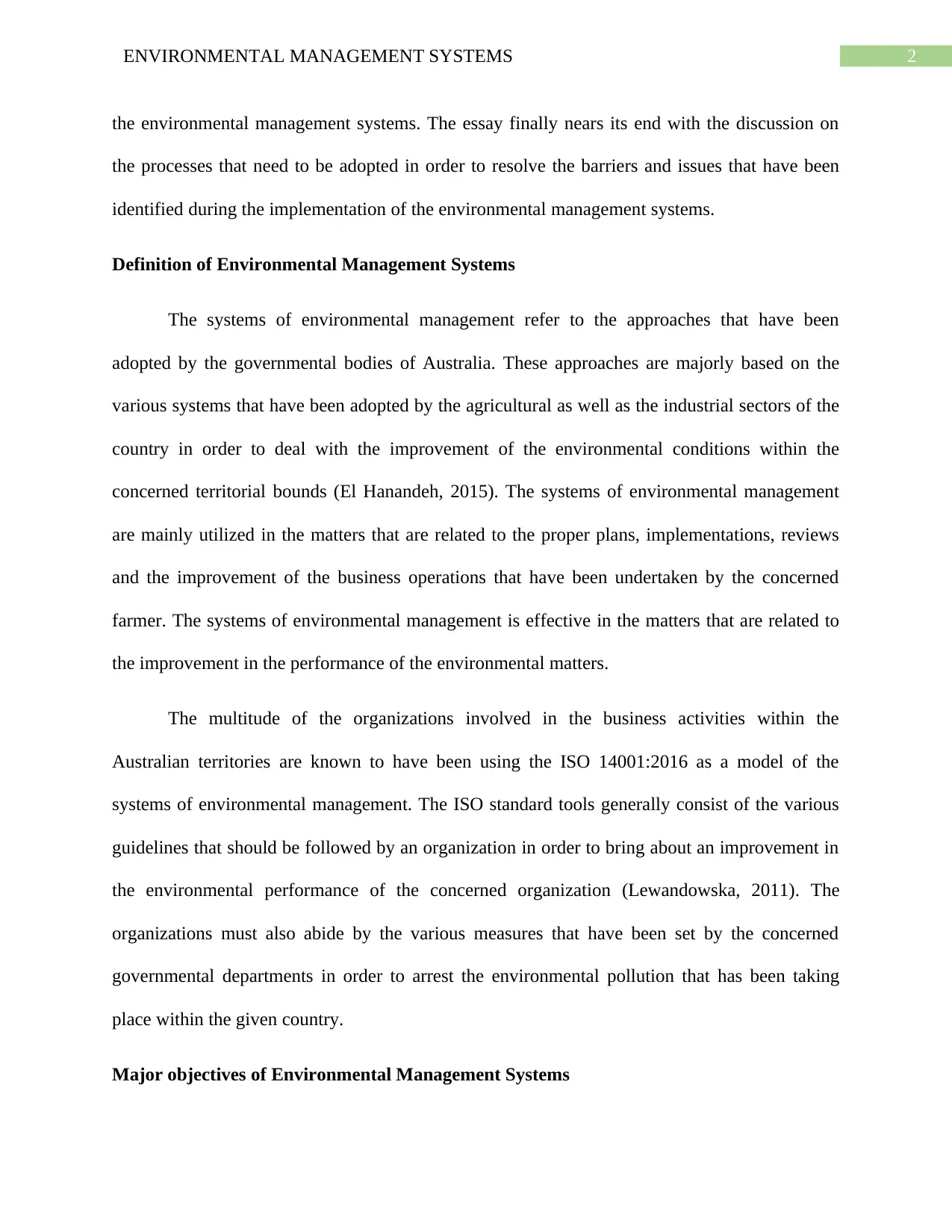
2ENVIRONMENTAL MANAGEMENT SYSTEMS
the environmental management systems. The essay finally nears its end with the discussion on
the processes that need to be adopted in order to resolve the barriers and issues that have been
identified during the implementation of the environmental management systems.
Definition of Environmental Management Systems
The systems of environmental management refer to the approaches that have been
adopted by the governmental bodies of Australia. These approaches are majorly based on the
various systems that have been adopted by the agricultural as well as the industrial sectors of the
country in order to deal with the improvement of the environmental conditions within the
concerned territorial bounds (El Hanandeh, 2015). The systems of environmental management
are mainly utilized in the matters that are related to the proper plans, implementations, reviews
and the improvement of the business operations that have been undertaken by the concerned
farmer. The systems of environmental management is effective in the matters that are related to
the improvement in the performance of the environmental matters.
The multitude of the organizations involved in the business activities within the
Australian territories are known to have been using the ISO 14001:2016 as a model of the
systems of environmental management. The ISO standard tools generally consist of the various
guidelines that should be followed by an organization in order to bring about an improvement in
the environmental performance of the concerned organization (Lewandowska, 2011). The
organizations must also abide by the various measures that have been set by the concerned
governmental departments in order to arrest the environmental pollution that has been taking
place within the given country.
Major objectives of Environmental Management Systems
the environmental management systems. The essay finally nears its end with the discussion on
the processes that need to be adopted in order to resolve the barriers and issues that have been
identified during the implementation of the environmental management systems.
Definition of Environmental Management Systems
The systems of environmental management refer to the approaches that have been
adopted by the governmental bodies of Australia. These approaches are majorly based on the
various systems that have been adopted by the agricultural as well as the industrial sectors of the
country in order to deal with the improvement of the environmental conditions within the
concerned territorial bounds (El Hanandeh, 2015). The systems of environmental management
are mainly utilized in the matters that are related to the proper plans, implementations, reviews
and the improvement of the business operations that have been undertaken by the concerned
farmer. The systems of environmental management is effective in the matters that are related to
the improvement in the performance of the environmental matters.
The multitude of the organizations involved in the business activities within the
Australian territories are known to have been using the ISO 14001:2016 as a model of the
systems of environmental management. The ISO standard tools generally consist of the various
guidelines that should be followed by an organization in order to bring about an improvement in
the environmental performance of the concerned organization (Lewandowska, 2011). The
organizations must also abide by the various measures that have been set by the concerned
governmental departments in order to arrest the environmental pollution that has been taking
place within the given country.
Major objectives of Environmental Management Systems
⊘ This is a preview!⊘
Do you want full access?
Subscribe today to unlock all pages.

Trusted by 1+ million students worldwide
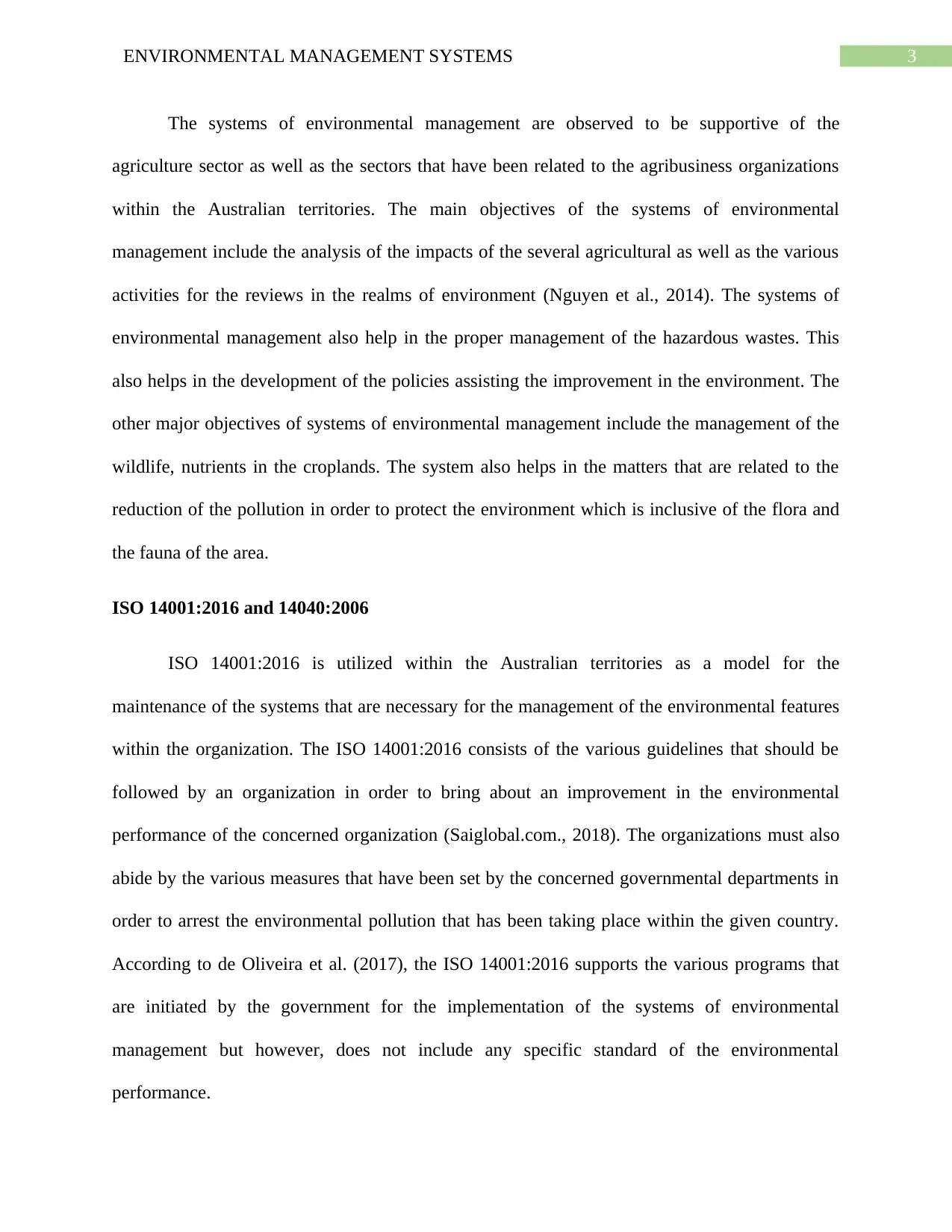
3ENVIRONMENTAL MANAGEMENT SYSTEMS
The systems of environmental management are observed to be supportive of the
agriculture sector as well as the sectors that have been related to the agribusiness organizations
within the Australian territories. The main objectives of the systems of environmental
management include the analysis of the impacts of the several agricultural as well as the various
activities for the reviews in the realms of environment (Nguyen et al., 2014). The systems of
environmental management also help in the proper management of the hazardous wastes. This
also helps in the development of the policies assisting the improvement in the environment. The
other major objectives of systems of environmental management include the management of the
wildlife, nutrients in the croplands. The system also helps in the matters that are related to the
reduction of the pollution in order to protect the environment which is inclusive of the flora and
the fauna of the area.
ISO 14001:2016 and 14040:2006
ISO 14001:2016 is utilized within the Australian territories as a model for the
maintenance of the systems that are necessary for the management of the environmental features
within the organization. The ISO 14001:2016 consists of the various guidelines that should be
followed by an organization in order to bring about an improvement in the environmental
performance of the concerned organization (Saiglobal.com., 2018). The organizations must also
abide by the various measures that have been set by the concerned governmental departments in
order to arrest the environmental pollution that has been taking place within the given country.
According to de Oliveira et al. (2017), the ISO 14001:2016 supports the various programs that
are initiated by the government for the implementation of the systems of environmental
management but however, does not include any specific standard of the environmental
performance.
The systems of environmental management are observed to be supportive of the
agriculture sector as well as the sectors that have been related to the agribusiness organizations
within the Australian territories. The main objectives of the systems of environmental
management include the analysis of the impacts of the several agricultural as well as the various
activities for the reviews in the realms of environment (Nguyen et al., 2014). The systems of
environmental management also help in the proper management of the hazardous wastes. This
also helps in the development of the policies assisting the improvement in the environment. The
other major objectives of systems of environmental management include the management of the
wildlife, nutrients in the croplands. The system also helps in the matters that are related to the
reduction of the pollution in order to protect the environment which is inclusive of the flora and
the fauna of the area.
ISO 14001:2016 and 14040:2006
ISO 14001:2016 is utilized within the Australian territories as a model for the
maintenance of the systems that are necessary for the management of the environmental features
within the organization. The ISO 14001:2016 consists of the various guidelines that should be
followed by an organization in order to bring about an improvement in the environmental
performance of the concerned organization (Saiglobal.com., 2018). The organizations must also
abide by the various measures that have been set by the concerned governmental departments in
order to arrest the environmental pollution that has been taking place within the given country.
According to de Oliveira et al. (2017), the ISO 14001:2016 supports the various programs that
are initiated by the government for the implementation of the systems of environmental
management but however, does not include any specific standard of the environmental
performance.
Paraphrase This Document
Need a fresh take? Get an instant paraphrase of this document with our AI Paraphraser
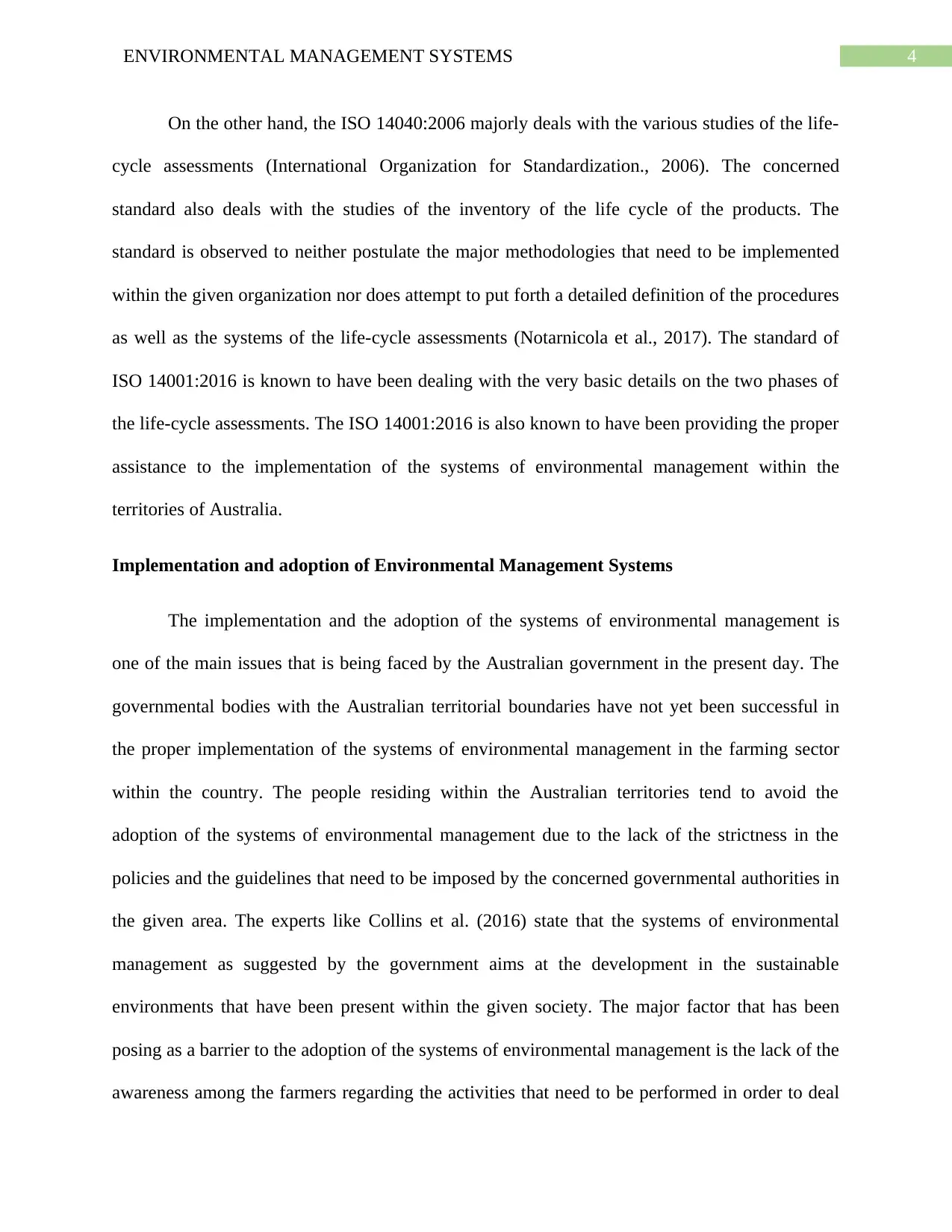
4ENVIRONMENTAL MANAGEMENT SYSTEMS
On the other hand, the ISO 14040:2006 majorly deals with the various studies of the life-
cycle assessments (International Organization for Standardization., 2006). The concerned
standard also deals with the studies of the inventory of the life cycle of the products. The
standard is observed to neither postulate the major methodologies that need to be implemented
within the given organization nor does attempt to put forth a detailed definition of the procedures
as well as the systems of the life-cycle assessments (Notarnicola et al., 2017). The standard of
ISO 14001:2016 is known to have been dealing with the very basic details on the two phases of
the life-cycle assessments. The ISO 14001:2016 is also known to have been providing the proper
assistance to the implementation of the systems of environmental management within the
territories of Australia.
Implementation and adoption of Environmental Management Systems
The implementation and the adoption of the systems of environmental management is
one of the main issues that is being faced by the Australian government in the present day. The
governmental bodies with the Australian territorial boundaries have not yet been successful in
the proper implementation of the systems of environmental management in the farming sector
within the country. The people residing within the Australian territories tend to avoid the
adoption of the systems of environmental management due to the lack of the strictness in the
policies and the guidelines that need to be imposed by the concerned governmental authorities in
the given area. The experts like Collins et al. (2016) state that the systems of environmental
management as suggested by the government aims at the development in the sustainable
environments that have been present within the given society. The major factor that has been
posing as a barrier to the adoption of the systems of environmental management is the lack of the
awareness among the farmers regarding the activities that need to be performed in order to deal
On the other hand, the ISO 14040:2006 majorly deals with the various studies of the life-
cycle assessments (International Organization for Standardization., 2006). The concerned
standard also deals with the studies of the inventory of the life cycle of the products. The
standard is observed to neither postulate the major methodologies that need to be implemented
within the given organization nor does attempt to put forth a detailed definition of the procedures
as well as the systems of the life-cycle assessments (Notarnicola et al., 2017). The standard of
ISO 14001:2016 is known to have been dealing with the very basic details on the two phases of
the life-cycle assessments. The ISO 14001:2016 is also known to have been providing the proper
assistance to the implementation of the systems of environmental management within the
territories of Australia.
Implementation and adoption of Environmental Management Systems
The implementation and the adoption of the systems of environmental management is
one of the main issues that is being faced by the Australian government in the present day. The
governmental bodies with the Australian territorial boundaries have not yet been successful in
the proper implementation of the systems of environmental management in the farming sector
within the country. The people residing within the Australian territories tend to avoid the
adoption of the systems of environmental management due to the lack of the strictness in the
policies and the guidelines that need to be imposed by the concerned governmental authorities in
the given area. The experts like Collins et al. (2016) state that the systems of environmental
management as suggested by the government aims at the development in the sustainable
environments that have been present within the given society. The major factor that has been
posing as a barrier to the adoption of the systems of environmental management is the lack of the
awareness among the farmers regarding the activities that need to be performed in order to deal
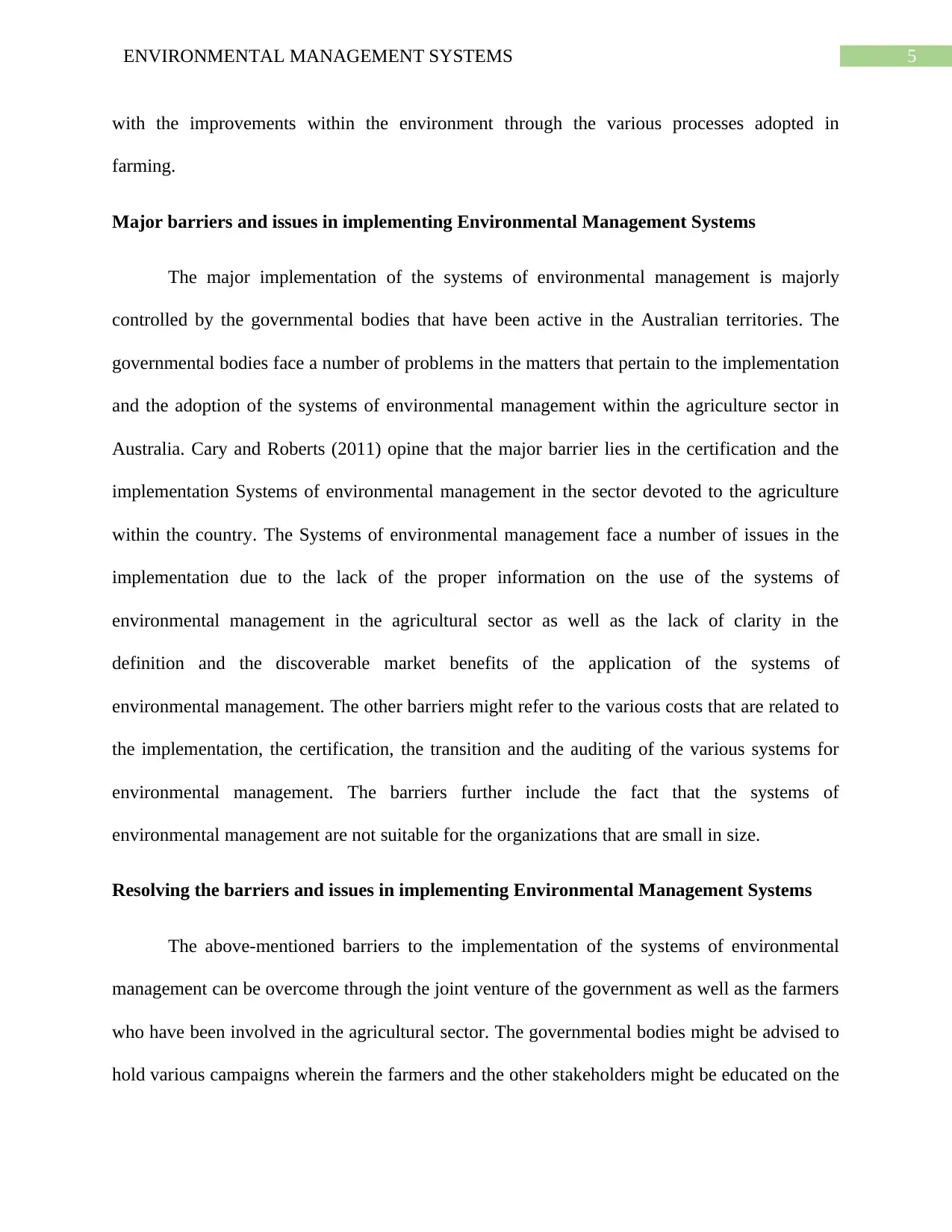
5ENVIRONMENTAL MANAGEMENT SYSTEMS
with the improvements within the environment through the various processes adopted in
farming.
Major barriers and issues in implementing Environmental Management Systems
The major implementation of the systems of environmental management is majorly
controlled by the governmental bodies that have been active in the Australian territories. The
governmental bodies face a number of problems in the matters that pertain to the implementation
and the adoption of the systems of environmental management within the agriculture sector in
Australia. Cary and Roberts (2011) opine that the major barrier lies in the certification and the
implementation Systems of environmental management in the sector devoted to the agriculture
within the country. The Systems of environmental management face a number of issues in the
implementation due to the lack of the proper information on the use of the systems of
environmental management in the agricultural sector as well as the lack of clarity in the
definition and the discoverable market benefits of the application of the systems of
environmental management. The other barriers might refer to the various costs that are related to
the implementation, the certification, the transition and the auditing of the various systems for
environmental management. The barriers further include the fact that the systems of
environmental management are not suitable for the organizations that are small in size.
Resolving the barriers and issues in implementing Environmental Management Systems
The above-mentioned barriers to the implementation of the systems of environmental
management can be overcome through the joint venture of the government as well as the farmers
who have been involved in the agricultural sector. The governmental bodies might be advised to
hold various campaigns wherein the farmers and the other stakeholders might be educated on the
with the improvements within the environment through the various processes adopted in
farming.
Major barriers and issues in implementing Environmental Management Systems
The major implementation of the systems of environmental management is majorly
controlled by the governmental bodies that have been active in the Australian territories. The
governmental bodies face a number of problems in the matters that pertain to the implementation
and the adoption of the systems of environmental management within the agriculture sector in
Australia. Cary and Roberts (2011) opine that the major barrier lies in the certification and the
implementation Systems of environmental management in the sector devoted to the agriculture
within the country. The Systems of environmental management face a number of issues in the
implementation due to the lack of the proper information on the use of the systems of
environmental management in the agricultural sector as well as the lack of clarity in the
definition and the discoverable market benefits of the application of the systems of
environmental management. The other barriers might refer to the various costs that are related to
the implementation, the certification, the transition and the auditing of the various systems for
environmental management. The barriers further include the fact that the systems of
environmental management are not suitable for the organizations that are small in size.
Resolving the barriers and issues in implementing Environmental Management Systems
The above-mentioned barriers to the implementation of the systems of environmental
management can be overcome through the joint venture of the government as well as the farmers
who have been involved in the agricultural sector. The governmental bodies might be advised to
hold various campaigns wherein the farmers and the other stakeholders might be educated on the
⊘ This is a preview!⊘
Do you want full access?
Subscribe today to unlock all pages.

Trusted by 1+ million students worldwide
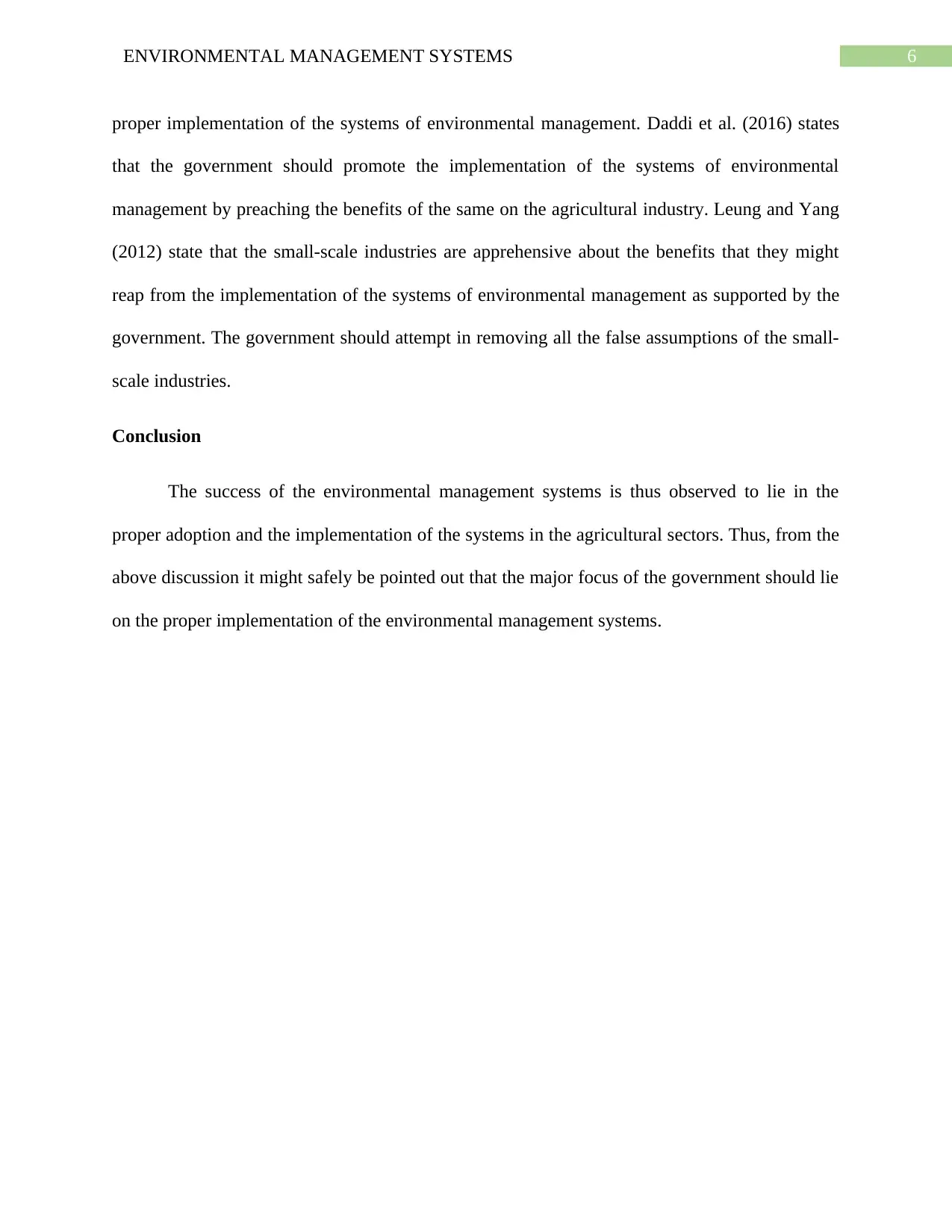
6ENVIRONMENTAL MANAGEMENT SYSTEMS
proper implementation of the systems of environmental management. Daddi et al. (2016) states
that the government should promote the implementation of the systems of environmental
management by preaching the benefits of the same on the agricultural industry. Leung and Yang
(2012) state that the small-scale industries are apprehensive about the benefits that they might
reap from the implementation of the systems of environmental management as supported by the
government. The government should attempt in removing all the false assumptions of the small-
scale industries.
Conclusion
The success of the environmental management systems is thus observed to lie in the
proper adoption and the implementation of the systems in the agricultural sectors. Thus, from the
above discussion it might safely be pointed out that the major focus of the government should lie
on the proper implementation of the environmental management systems.
proper implementation of the systems of environmental management. Daddi et al. (2016) states
that the government should promote the implementation of the systems of environmental
management by preaching the benefits of the same on the agricultural industry. Leung and Yang
(2012) state that the small-scale industries are apprehensive about the benefits that they might
reap from the implementation of the systems of environmental management as supported by the
government. The government should attempt in removing all the false assumptions of the small-
scale industries.
Conclusion
The success of the environmental management systems is thus observed to lie in the
proper adoption and the implementation of the systems in the agricultural sectors. Thus, from the
above discussion it might safely be pointed out that the major focus of the government should lie
on the proper implementation of the environmental management systems.
Paraphrase This Document
Need a fresh take? Get an instant paraphrase of this document with our AI Paraphraser
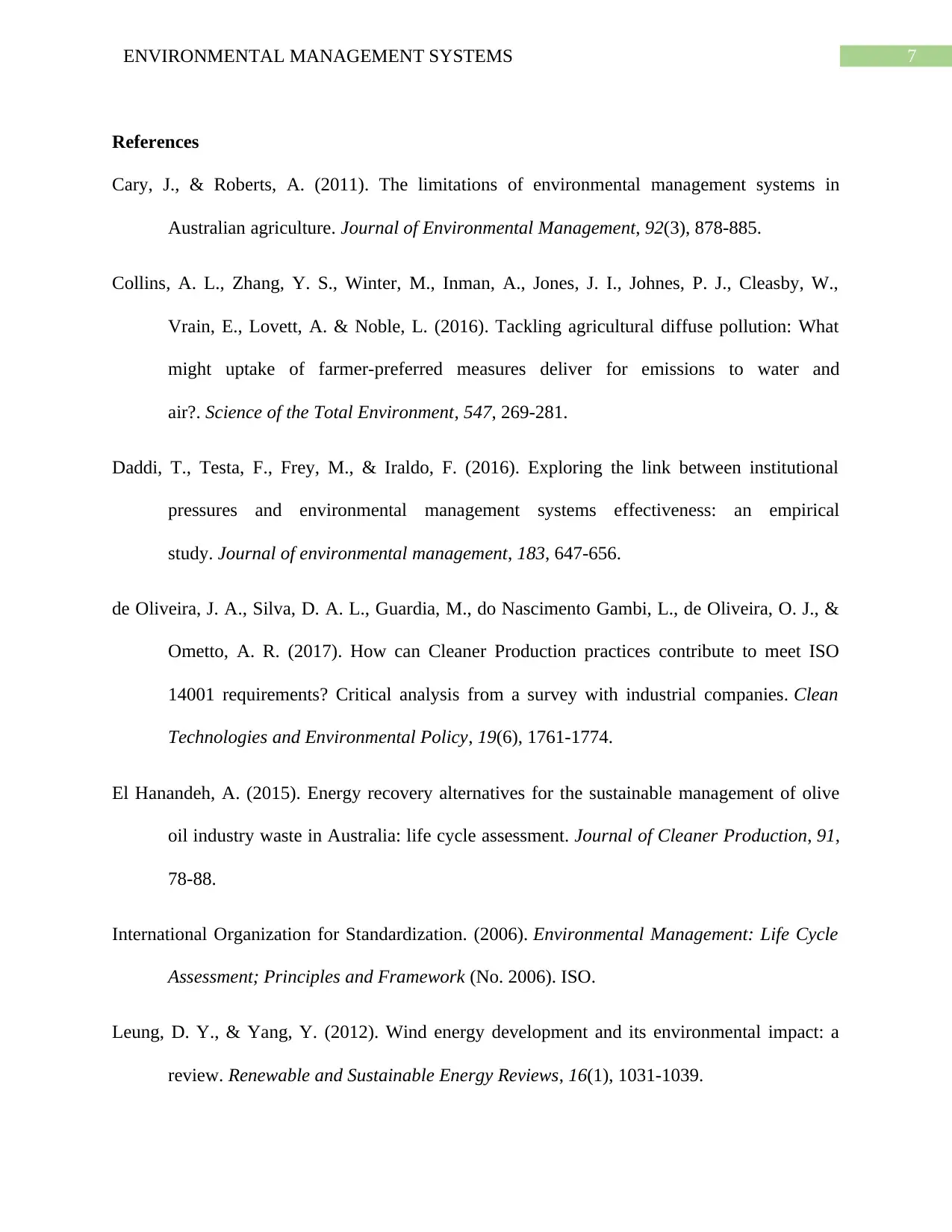
7ENVIRONMENTAL MANAGEMENT SYSTEMS
References
Cary, J., & Roberts, A. (2011). The limitations of environmental management systems in
Australian agriculture. Journal of Environmental Management, 92(3), 878-885.
Collins, A. L., Zhang, Y. S., Winter, M., Inman, A., Jones, J. I., Johnes, P. J., Cleasby, W.,
Vrain, E., Lovett, A. & Noble, L. (2016). Tackling agricultural diffuse pollution: What
might uptake of farmer-preferred measures deliver for emissions to water and
air?. Science of the Total Environment, 547, 269-281.
Daddi, T., Testa, F., Frey, M., & Iraldo, F. (2016). Exploring the link between institutional
pressures and environmental management systems effectiveness: an empirical
study. Journal of environmental management, 183, 647-656.
de Oliveira, J. A., Silva, D. A. L., Guardia, M., do Nascimento Gambi, L., de Oliveira, O. J., &
Ometto, A. R. (2017). How can Cleaner Production practices contribute to meet ISO
14001 requirements? Critical analysis from a survey with industrial companies. Clean
Technologies and Environmental Policy, 19(6), 1761-1774.
El Hanandeh, A. (2015). Energy recovery alternatives for the sustainable management of olive
oil industry waste in Australia: life cycle assessment. Journal of Cleaner Production, 91,
78-88.
International Organization for Standardization. (2006). Environmental Management: Life Cycle
Assessment; Principles and Framework (No. 2006). ISO.
Leung, D. Y., & Yang, Y. (2012). Wind energy development and its environmental impact: a
review. Renewable and Sustainable Energy Reviews, 16(1), 1031-1039.
References
Cary, J., & Roberts, A. (2011). The limitations of environmental management systems in
Australian agriculture. Journal of Environmental Management, 92(3), 878-885.
Collins, A. L., Zhang, Y. S., Winter, M., Inman, A., Jones, J. I., Johnes, P. J., Cleasby, W.,
Vrain, E., Lovett, A. & Noble, L. (2016). Tackling agricultural diffuse pollution: What
might uptake of farmer-preferred measures deliver for emissions to water and
air?. Science of the Total Environment, 547, 269-281.
Daddi, T., Testa, F., Frey, M., & Iraldo, F. (2016). Exploring the link between institutional
pressures and environmental management systems effectiveness: an empirical
study. Journal of environmental management, 183, 647-656.
de Oliveira, J. A., Silva, D. A. L., Guardia, M., do Nascimento Gambi, L., de Oliveira, O. J., &
Ometto, A. R. (2017). How can Cleaner Production practices contribute to meet ISO
14001 requirements? Critical analysis from a survey with industrial companies. Clean
Technologies and Environmental Policy, 19(6), 1761-1774.
El Hanandeh, A. (2015). Energy recovery alternatives for the sustainable management of olive
oil industry waste in Australia: life cycle assessment. Journal of Cleaner Production, 91,
78-88.
International Organization for Standardization. (2006). Environmental Management: Life Cycle
Assessment; Principles and Framework (No. 2006). ISO.
Leung, D. Y., & Yang, Y. (2012). Wind energy development and its environmental impact: a
review. Renewable and Sustainable Energy Reviews, 16(1), 1031-1039.
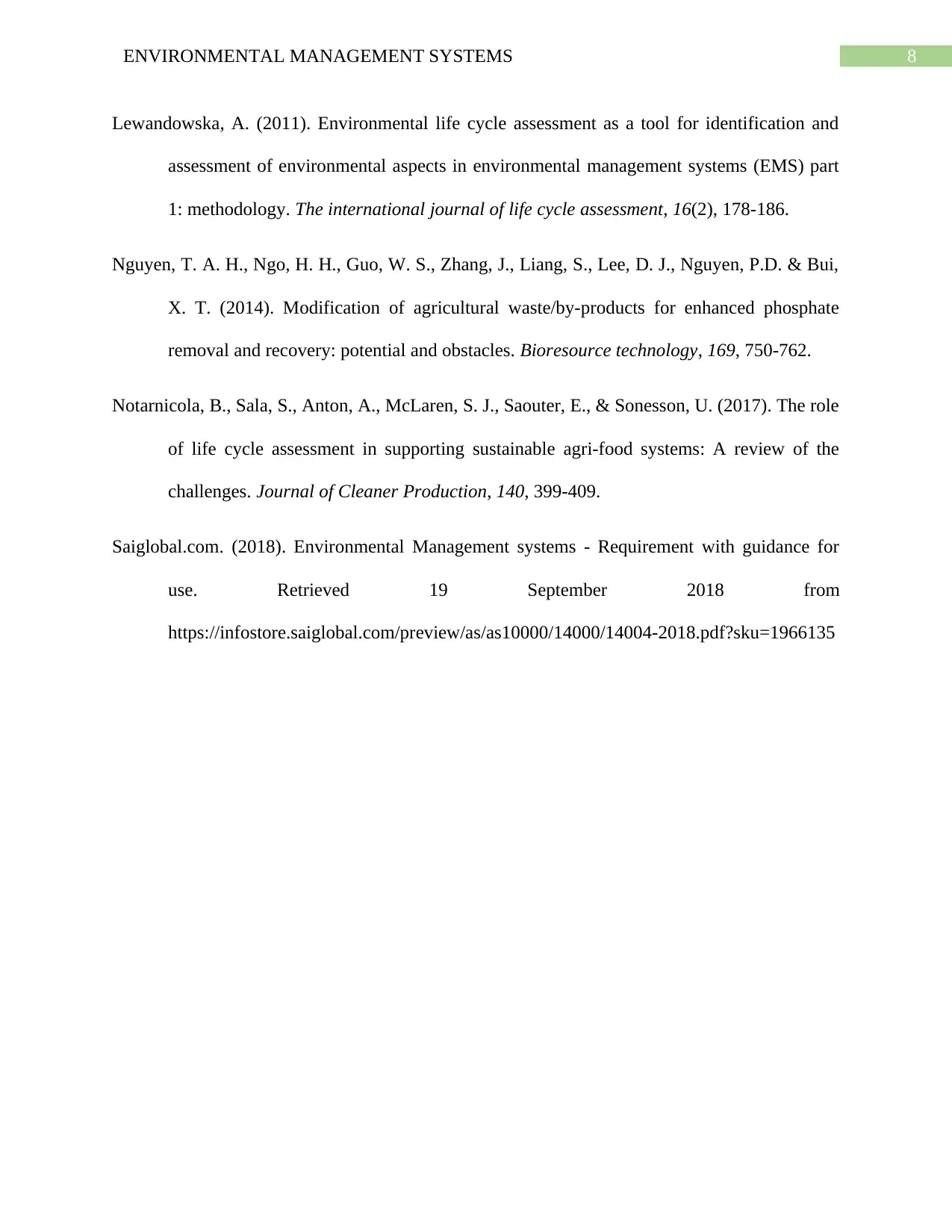
8ENVIRONMENTAL MANAGEMENT SYSTEMS
Lewandowska, A. (2011). Environmental life cycle assessment as a tool for identification and
assessment of environmental aspects in environmental management systems (EMS) part
1: methodology. The international journal of life cycle assessment, 16(2), 178-186.
Nguyen, T. A. H., Ngo, H. H., Guo, W. S., Zhang, J., Liang, S., Lee, D. J., Nguyen, P.D. & Bui,
X. T. (2014). Modification of agricultural waste/by-products for enhanced phosphate
removal and recovery: potential and obstacles. Bioresource technology, 169, 750-762.
Notarnicola, B., Sala, S., Anton, A., McLaren, S. J., Saouter, E., & Sonesson, U. (2017). The role
of life cycle assessment in supporting sustainable agri-food systems: A review of the
challenges. Journal of Cleaner Production, 140, 399-409.
Saiglobal.com. (2018). Environmental Management systems - Requirement with guidance for
use. Retrieved 19 September 2018 from
https://infostore.saiglobal.com/preview/as/as10000/14000/14004-2018.pdf?sku=1966135
Lewandowska, A. (2011). Environmental life cycle assessment as a tool for identification and
assessment of environmental aspects in environmental management systems (EMS) part
1: methodology. The international journal of life cycle assessment, 16(2), 178-186.
Nguyen, T. A. H., Ngo, H. H., Guo, W. S., Zhang, J., Liang, S., Lee, D. J., Nguyen, P.D. & Bui,
X. T. (2014). Modification of agricultural waste/by-products for enhanced phosphate
removal and recovery: potential and obstacles. Bioresource technology, 169, 750-762.
Notarnicola, B., Sala, S., Anton, A., McLaren, S. J., Saouter, E., & Sonesson, U. (2017). The role
of life cycle assessment in supporting sustainable agri-food systems: A review of the
challenges. Journal of Cleaner Production, 140, 399-409.
Saiglobal.com. (2018). Environmental Management systems - Requirement with guidance for
use. Retrieved 19 September 2018 from
https://infostore.saiglobal.com/preview/as/as10000/14000/14004-2018.pdf?sku=1966135
⊘ This is a preview!⊘
Do you want full access?
Subscribe today to unlock all pages.

Trusted by 1+ million students worldwide
1 out of 9
Related Documents
Your All-in-One AI-Powered Toolkit for Academic Success.
+13062052269
info@desklib.com
Available 24*7 on WhatsApp / Email
![[object Object]](/_next/static/media/star-bottom.7253800d.svg)
Unlock your academic potential
Copyright © 2020–2025 A2Z Services. All Rights Reserved. Developed and managed by ZUCOL.





